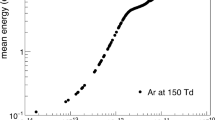Abstract
A laboratory gun that uses compressed gas as its propellant was designed and tested for the study of small projectiles traveling in soils with initial velocities ranging from 50 to 200 m/s. The gun employed the use of air or helium with an electrically triggered, pneumatically piloted, solenoid valve. The triggering system was designed to provide remote activation. A photo gate speedometer was utilized to measure the exit velocity of each projectile. Details of the electro-pneumatic control system are presented in this paper along with the design of the gun assembly and its subsystems. The effects of different design parameters, including muzzle length, projectile mass, propellant type, and volume of compressed gas utilized, on projectile velocity were investigated. Statistical analysis of the gun performance is presented. The gun is currently being used to visualize the fundamental physics of rapid earth penetration in soils, using transparent soils.
Similar content being viewed by others
References
Zukas, J., Theodore, N., Swift, H., Greszczuk, L., and Curran, D., Impact Dynamics, Wiley Publishing, New York (1982).
Heuze, F.E., “An Overview of Projectile Penetration into Geological Materials, with Emphasis on Rocks,” International Journal of Rock mechanics and Mining Science and Geomechanical Abstracts 27(1):1–14 (1990).
Omidvar, M., Iskander, M., and Bless, S., “Response of Granular Media to Rapid Penetration,” International Journal of Impact Engineering 66:60–82 (2014). DOI: 10.1016/j.ijimpeng.2013.12.004
Guzman, I., and Iskander, M., “Geotechnical Properties of Sucrose-Saturated Fused Quartz for Use in Physical Modeling,” Geotechnical Testing Journal 36(3):139–150 (2013). DOI: 10.1520/GTJ20130037
Guzman, I., Iskander, M., Suescun, E., and Omidvar, M., “A Transparent Aqueous-Saturated Sand-Surrogate for use in Physical Modeling,” Acta Geotechnica 9(2):187–206 (2014). DOI: 10.1007/s11440-013-0247-2
Iskander, M., Modeling with Transparent Soils, Springer-Verlag, Berlin, Germany (2010).
Sadek, S., Iskander, M., and Liu, J., “Accuracy of Digital Image Correlation for Measuring Deformations in Transparent Media,” ASCE Journal of Computing in Civil Engineering 17(2):88–96 (2003).
Liu, J., and Iskander, M., “Adaptive Cross Correlation for Imaging Displacements in Soils,” ASCE Journal of Computing in Civil Engineering 18(1):46–57 (2004).
Iskander, M., and Liu, J., “Spatial deformation measurement using transparent soil,” Geotechnical Testing Journal 33(4):1–7 (2010).
Liu, J., and Iskander, M., “Laboratory Investigation of the Modeling Capacity of Synthetic Transparent Soils” Canadian Geotechnical Journal 47(4):451–460 (2010). DOI: 10.1139/T09-116
Thompson, J., 1975, “Low-Velocity Impact Penetration of Low-Cohesion Soil Deposits,” Ph.D. Dissertation, University of California, Berkeley, CA.
Borg, J.P., and Vogler, T.J., “An experimental Investigation of a High Velocity Projectile Penetrating Sand,” Proceedings of the XIth International Congress and Exposition, Society for Experimental Mechanics Inc., Orlando, FL (2008).
Bresie, D., and Ingram, S., “Coilgun Technology at the Center For Electromechanics, The University of Texas at Austin,” IEEE Transactions on Magnetics 29(1):648–654 (1993).
Hoff, A., Airguns and Other Pneumatic Arms, Barrie and Jenkins, London, UK (1972).
Borg, J., Morrisseya, M., Pericha, C., Voglerb, T., and Chhabildas, L., “In Situ Velocity and Stress Characterization of a Projectile Penetrating a Sand Target: Experimental Measurements and Continuum Simulations,” International Journal of Impact Engineering 51:23–35 (2013).
White, F., Fluid Mechanics, 4th Edition, McGraw Hill, New York (1999).
Canning, T. N., James, C.S., and Seiff, A., 1970, “Ballistic Range Techlonogy,” AGARD-AG-138, NATO Science and Technology Organization.
Charters, A., “Development of the High-Velocity Gas-Dynamics Gun,” International Journal of Impact Engineering 5(1–4):181–203 (1987).
Charters, A., “The early years of aerodynamics ranges, light-gas guns, and high-velocity impact,” International Journal of Impact Engineering 17(1–3):151–182 (1995).
Considine, D., Process Instruments and Controls Handbook, 2nd Edition, McGraw-Hill Book Company, New York (1957).
Zappe, R.W., Valve Selection Handbook, 2nd Edition, Gulf Publishing Company, Houston, TX (1987).
Palisade Corporation. @Risk Software User Guide, Risk Analysis and Simulation Add-In for Microsoft Excel, Version 6, Palisade Corporation, 2013, URL http://www.palisade.com [accessed on 22 April 2013].
Author information
Authors and Affiliations
Corresponding author
Rights and permissions
About this article
Cite this article
Cave, A., Roslyakov, S., Iskander, M. et al. Design and Performance of a Laboratory Pneumatic Gun for Soil Ballistic Applications. Exp Tech 40, 541–553 (2016). https://doi.org/10.1007/s40799-016-0055-3
Published:
Issue Date:
DOI: https://doi.org/10.1007/s40799-016-0055-3




